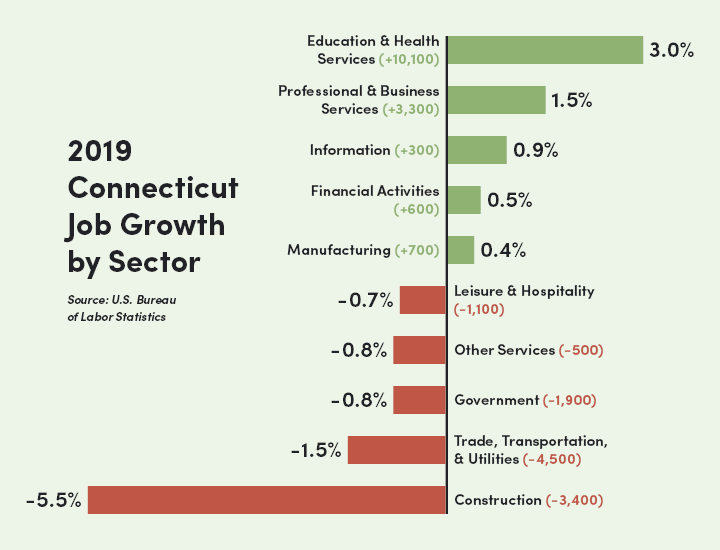How Will Lawmakers Respond to Jobs Picture?

Connecticut employers added 3,600 net new jobs in 2019, with private sector employment gains at 5,500 positions or 0.4%, the second slowest year over the last decade.
“That’s a fairly weak number, especially when you compare it to the region and the country,” CBIA economic adviser Pete Gioia said.

Connecticut’s overall 2019 job growth was just 0.2%. The New England states averaged 0.9%, while the U.S. averaged 1.4%.
Private sector job growth averaged 1.1% in the six New England states and 1.5% in the U.S. last year.
Rhode Island led the region in percentage terms in 2019, adding 8,400 private sector jobs or 1.9% growth.
“That’s nearly five times what happened in Connecticut,” Gioia said. “Policymakers have got to focus on expanding the economy and driving job growth.”
Recovery
Massachusetts added 43,300 private sector jobs (1.4%), followed by Maine (7,400; 1.4%), and New Hampshire (7,500; 1.3%).
Vermont (400 jobs; 0.2%) was the only New England state with slower private sector job growth than Connecticut last year.
Connecticut is one of the few states yet to reach post-recession recovery, regaining 86% of all jobs lost in the 2008-2010 economic downturn.
“It’s time for us to get our economy in gear.”
CBIA economic adviser Pete Gioia
The state’s private sector is in expansion mode at 107% recovery. The New England private sector average is 232% and the U.S. is at 262%.
Connecticut’s unemployment rate is 3.7%, an 18-year low and two-tenths of a point above the national rate.
Gioia noted the state’s GDP expanded in each of the first three quarters of 2019, “which means we have the opportunity to drive greater job growth.”
Legislative Session
He said job growth must shape legislative priorities when the 2020 General Assembly session begins Feb. 5.
Addressing the state’s long-term fiscal stability and improving its business climate to attract private sector investment were two critical issue areas Gioia cited.
He also called for expanding workforce development efforts, particularly in key sectors such as manufacturing and financial activities.
“If you take a look at the annual numbers, we added 700 manufacturing jobs, which is positive, but given the needs of that industry, we should be adding 7,000 jobs,” he said.
“In financial activities, another high-paying sector, we added 600 jobs. Which again, is better than a loss, but that should have been 6,000 new jobs.
“It’s time for us to get our economy in gear and policymakers have to do things that help us get there.”
Sectors, Labor Markets
Five of the state’s 10 main industry sectors added jobs in 2019, led by education and health services, which increased by 10,100 positions (3%).
Professional and business services grew by 3,300 jobs (1.5%), followed by information (300; 0.9%), financial activities (600; 0.5%); and manufacturing (700; 0.4%).
Construction led all losing sectors in percentage terms, dropping 3,400 jobs or 5.5%, while trade, transportation, and utilities lost 4,500 positions (-1.5%).

The government sector—which includes the two tribal casinos and state, local, and federal government employment—fell by 1,900 jobs (-0.8%), other services dropped 500 (0.8%), and leisure and hospitality declined 1,100 (-0.7%).
Bridgeport-Stamford-Norwalk added 1,900 jobs last year (0.7%), the most of any of the state’s main labor market areas.
New Haven gained 1,800 (0.6%) and Danbury added 100 jobs (0.1%). Norwich-New London-Westerly was unchanged for the year.
Hartford lost 1,600 jobs (-0.3%) and Waterbury shed 500 positions (-0.7%).
RELATED
EXPLORE BY CATEGORY
Stay Connected with CBIA News Digests
The latest news and information delivered directly to your inbox.


